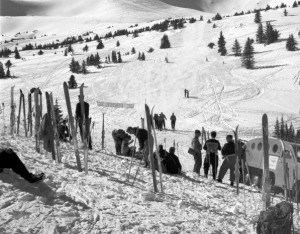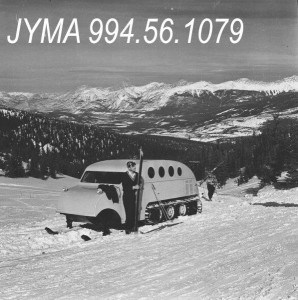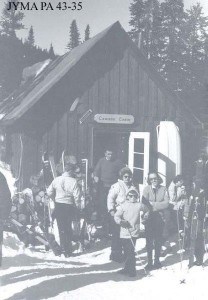
Before there were chalets; before there were high-speed lifts and groomed runs; before any roads led there or it even had a name, mountaineer Joe Weiss trekked on a pair of wooden skies into the area he would later call Marmot Basin.
Although some local skiers say Jasperites skied Marmot before Weiss, it was the Swiss mountaineering guide who opened the area up to skiing.
Weiss discovered Marmot’s ski potential in the 1920s. He immediately saw its potential as a ski destination and blazed the first trail there in the 30s, bringing tours through the area.
Gord Ruddy has been skiing the mountain since he was a toddler. In the 50s his father Bill ran the snowmobiles that hauled skiers to Marmot from the Athabasca Hotel in Jasper.
Many of his fondest childhood memories are of zipping around the mountain with a group of kids.
“You would climb to the top, pull your hat down and let ‘er rip,” he said, “just go ski the whole mountain, without any tracks in front of you.
“As far as I’m concerned that’s the reason that God gave us mountains: you can climb to the top of them and ski all the way down in the winter.”

Ruddy’s childhood memories are of untouched powder, and climbing 40 minutes to the top of the hill in homemade ski skins for a single run to the bottom. Those wilder days lasted until about the early 60s, when development at Marmot ramped up.
Toby Rayner took over in 1960 and in 1961 installed the hill’s first tow rope, powered by an old army truck.
The next big step for Marmot came in 1964 when Parks Canada granted a group of businessmen led by Kurt Kiefer a License of Operation to develop the hill.
John Ogilvy, who in the 70s helped build ski lifts across the Rockies, remembers the era when skiing gained popularity. He said “it was kind of a race to build lifts,” and every couple of years Marmot was putting up a new one.
In 1968, the Tranquilizer chair was installed, opening up access from the base area, as it now exists. Around that time Marmot also officially took over trail grooming and the ski patrol from Parks Canada.
As the mountain continued developing, skiers were doing whatever they could to bring people to the hill. Joe Couture, who was a ski school instructor at Marmot, as well as a marketing manager, remembers booting it to the Prairies every year to bring ski clubs to the hill, back when five-night ski packages cost $82.
“In the early days of the ski industry everybody loved skiing; that’s why they were in the industry. And that’s why we promoted it, and sold it. That was the whole secret of survival was to sell people to come to ski,” he said.
That attitude paid off, as the number of visitors to the hill rose every year. To keep up with all the people, Marmot continued to put in new lifts and upgrade the chalets.
During the 1970s, a modern highway opened access to Marmot, and the ski area continued to install new lifts and open new areas.
The Caribou Chair opened in 1971 and, following that, the Kiefer T-bar in 1974, and the Knob Chair in 1976, giving convenient access to the upper mountain areas.
However, as facilities developed and the sport grew, many skiers still kept a wild and adventurous attitude. This was exemplified by the brief but memorable run of an event Ogilvy and Couture remember as the “Kubasa Capers.”

It started as a Ukrainian ski week in the early 70s, but in just a few short years grew to what Couture called “the largest party in western Canada at any ski hill anywhere.”
He said in the last years of the event, busses would roll into town full of people with no place to stay. Rather they would just party all weekend long.
“We just went crazy,” Ogilvy remembered with a laugh.
Couture remembered being on the ski hill one year and hearing a strange sound.
Suddenly, a man wearing nothing but a pair of skis flew down the hill bleating Lucielle Ball’s show-tune “Hey! Look Me Over” on a trumpet.
After he crashed into the thousands-large crowd at the bottom of the hill, police picked him up and threw him in jail.
That same night Couture was at a dance when the same man came streaking through the hall, still blaring his horn.
Parks Canada shut down the event for good that year.
Things were fairly quiet through the 80s and 90s, until Marmot Basin installed its first high-speed detachable quad chairlift, the Eagle Express, in 1990. Through the 90s and 2000s more lifts were built and areas expanded. In 2006 Marmot invested more than $8 million in 10 snow machines, allowing them to significantly extend their season.
Today, Marmot Basin boasts 80 runs and 1,500 acres of skiable terrain.
This year marks the hill’s official 50th anniversary, and the aim is to kick off earlier than ever, on Nov. 8.
Such an opening is made possible by the snow machines, which start pumping out powder as soon as the mercury drops and stays below zero.
The guns powered up for the first time this week and they’ll continue puking snow throughout the season, keeping a solid base on the lower mountain and providing enough snow to construct the terrain park.
For up to date snow reports and more information about Marmot Basin, visit skimarmot.com.
Trevor Nichols
[email protected]
